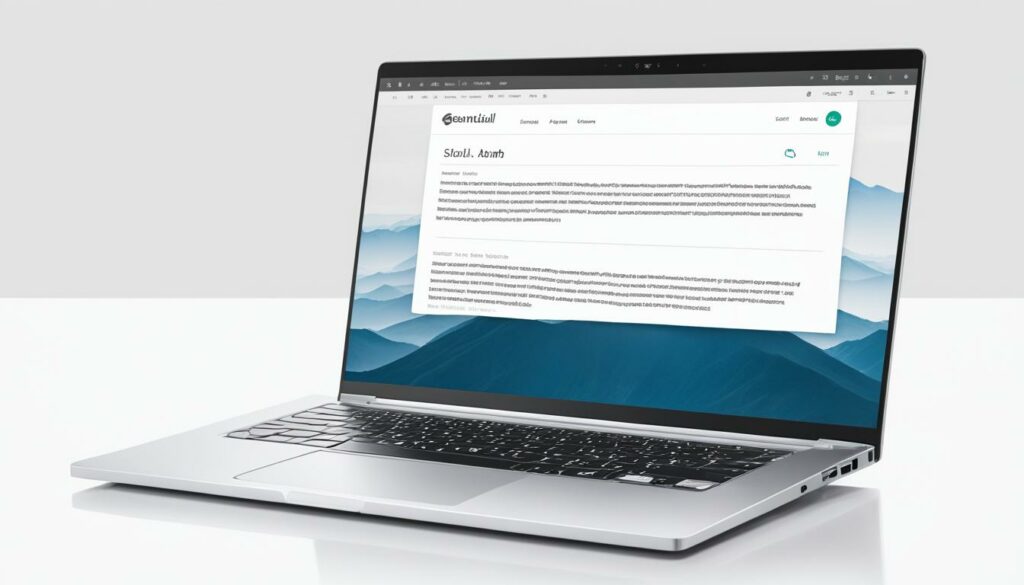The Apache Web server is currently the most frequently deployed Web server. Apache is considered to be relatively easier to secure compared to Microsoft’s Internet Information Server (IIS). However, securing your Apache server still requires some effort. This section will provide guidelines and measures to achieve baseline security in Apache Web servers.
Key Takeaways:
- Obtain a secure version of Apache for your operating system and follow the installation instructions.
- Properly configure your Apache server to enhance security, including avoiding running with superuser privileges.
- Use the mod_access module to restrict access to certain directories based on hostname, IP address, or username and password.
- Set appropriate file system permissions to ensure that unprivileged users cannot modify critical directories or files.
- Regularly monitor your Apache server’s log files to detect and identify potential security threats.
Secure Installation and Configuration
To ensure the security of your Apache Web server, it is crucial to start with a secure installation. Here are some tips and best practices to follow:
- Obtain a secure version of Apache: Make sure to download the latest stable release of Apache from the official website or trusted sources. Keep in mind that older versions may have known vulnerabilities.
- Follow installation instructions: Carefully read and follow the installation instructions provided for your specific operating system. This will help you set up Apache correctly and avoid common security pitfalls.
- Configure your Apache server: Properly configuring your Apache server is crucial for enhancing security. Here are a few key considerations:
- Avoid running with superuser privileges: Running your Apache server with root or administrative privileges is a security risk. Instead, create a dedicated user account for running the server to minimize potential damage from security breaches.
- Separate web-related directories from system directories: Keep your web-related directories and files separate from system directories. This helps to prevent unauthorized access to critical system files.
- Compartmentalize the web directory structure: Organize your web directory structure to minimize the potential impact of a compromised website. Use separate directories for different websites and consider implementing virtual hosts to isolate them.
Remember, a secure installation and configuration are the foundational steps to safeguard your Apache server. By following these tips, you can reduce the risk of security breaches and strengthen the overall security posture of your server.
“A secure installation and configuration are the first line of defense for your Apache server. Take the necessary precautions to minimize potential security risks.”
Access Control and Permissions
Securing your Apache server requires implementing access control measures and setting appropriate permissions to restrict unauthorized access to directories, files, and documents. By following these security practices, you can ensure the integrity and confidentiality of your server.
Restricting Directory Access
One of the essential Apache server security measures is restricting access to specific directories. The mod_access module allows you to control access based on various criteria, including hostname, IP address, and username/password combinations. By utilizing this module, you can prevent unauthorized individuals from accessing sensitive directories.
Here is an example of how to restrict directory access based on IP addresses:
<Directory /var/www/secure_directory>
Order deny,allow
Deny from all
Allow from 192.168.1.0/24
</Directory>
This configuration allows access to the /var/www/secure_directory only from the IP range 192.168.1.0/24, denying access to all other IP addresses.
Setting File System Permissions
To prevent unauthorized modifications to critical directories and files, it is crucial to set appropriate file system permissions. By assigning proper permissions, you can restrict access to sensitive information and prevent potential security breaches.
Here are some common file system permissions:
- Read-only (400 or r–): Only allows reading the file, preventing any modifications.
- Read and write (600 or rw-): Allows both reading and modifying the file.
- Read and execute (500 or r-x): Allows reading and executing a file, but not modifying it.
- Read, write, and execute (700 or rwx): Provides full access to a file, allowing reading, modifying, and executing.
By carefully assigning appropriate permissions to directories and files, you can ensure that unprivileged users cannot make unauthorized changes.
Restricting Access to Files and Documents
In addition to directory access, it is essential to restrict access to individual files and documents. You can achieve this by using the mod_rewrite module, which allows you to define rules for accessing specific files or file types.
Here is an example of how to restrict access to all .conf files:
<FilesMatch “\\.conf$”>
Order deny,allow
Deny from all
</FilesMatch>
This configuration denies access to all files with the .conf extension, ensuring that sensitive configuration files remain inaccessible to unauthorized users.
When dealing with third-party content providers, exercise caution and thoroughly vet their security measures. Ensure that they follow best practices and maintain robust security protocols to prevent any potential security risks.

| Apache Server Security Measures | Benefits |
|---|---|
| Restricting directory access | Prevents unauthorized access to sensitive directories |
| Setting file permissions | Prevents unprivileged users from modifying critical directories and files |
| Restricting access to files and documents | Enhances confidentiality by controlling access to individual files |
Regular Log Monitoring
Regularly monitoring your Apache server’s log files is a crucial aspect of ensuring the security of your server. By diligently analyzing the log files, you can detect and identify potential security threats, allowing you to take appropriate actions to mitigate any risks. Log file monitoring provides valuable insights into the activities and interactions happening on your server, enabling you to stay one step ahead of potential attackers.
Through log file monitoring, you can:
- Identify unusual or suspicious activities that may indicate a security breach
- Track access attempts from unauthorized IP addresses or unusual user behavior
- Identify patterns of attacks or targeted vulnerabilities
- Monitor for abusive or excessive usage of server resources
- Track error messages and server malfunctions
To effectively monitor your log files, consider using log analysis tools or software that can help automate the process. These tools can assist in aggregating and parsing log data, providing you with a comprehensive view of your server’s activity. By setting up alerts and notifications based on certain log file events, you can proactively respond to potential threats and minimize the impact of security incidents.
Remember to prioritize log file monitoring as part of your overall Apache server security strategy. Regularly schedule log file reviews and ensure that relevant stakeholders have access to the information. By staying vigilant and proactive in monitoring your log files, you can enhance the security of your Apache server and protect your valuable data from potential threats.

Example of Log File Monitoring Tools
| Tool | Description |
|---|---|
| 1. ELK Stack (Elasticsearch, Logstash, Kibana) | A powerful open-source log analysis platform that provides real-time insights and visualization of log data. |
| 2. Splunk | A comprehensive log analysis tool that offers advanced search capabilities, data visualization, and alerts for security-related events. |
| 3. Graylog | An open-source log management platform that allows you to collect, index, and analyze log data from various sources. |
| 4. Nagios Log Server | A log management system with powerful search and analysis features, providing insights into log data for troubleshooting and security purposes. |
Table: Example of Log File Monitoring Tools
Vulnerability Assessment and Patch Management
Regularly assessing your Apache server for vulnerabilities is crucial to maintaining its security. Conduct vulnerability scans to identify any weaknesses that could potentially be exploited by attackers. Additionally, staying informed about security advisories from Apache and your operating system vendor can help you proactively address any vulnerabilities that may arise.
Once vulnerabilities are identified, it is essential to take prompt action to mitigate them. One of the most effective measures you can take is to keep your server and all installed software up to date. Installing patches and updates as soon as they are released ensures that your server is protected against known vulnerabilities and exploits.
Patching your server and software should be a regular practice. A comprehensive patch management strategy involves:
- Regularly checking for updates: Keep an eye on Apache’s official website and your operating system vendor’s platforms for the latest security updates and patches.
- Reviewing changelogs: Before applying updates, review the changelogs to understand the specific security vulnerabilities being addressed.
- Testing patches in a controlled environment: Before applying updates to your production environment, test them in a controlled setting to ensure they don’t cause any compatibility or functionality issues.
- Implementing a patch management policy: Develop a clear policy outlining the procedures and responsibilities for applying patches and updates to your Apache server.
By following these practices, you can mitigate the risk of known vulnerabilities being exploited, strengthen your server’s security, and ensure the smooth operation of your website.
“Regularly assessing and patching your Apache server is like fortifying the walls of your digital fortress, fending off potential threats and protecting your valuable data from falling into the wrong hands.”
Take a look at the following table for a simplified overview of key steps in vulnerability assessment and patch management:
| Steps | Actions |
|---|---|
| 1 | Conduct vulnerability scans |
| 2 | Stay updated with security advisories |
| 3 | Install patches and updates |
| 4 | Regularly check for updates |
| 5 | Review changelogs |
| 6 | Test patches in a controlled environment |
| 7 | Implement a patch management policy |
By following these best practices in vulnerability assessment and patch management, you can effectively minimize the risks posed by potential security vulnerabilities in your Apache server, providing a safer environment for your website and its users.

Secure Data Transfer and Protocols
When it comes to Apache server security, one crucial aspect to consider is the secure transfer of data. To safeguard your sensitive information, it is essential to use secure protocols such as SSH (Secure Shell) and SFTP (Secure File Transfer Protocol). These protocols provide encryption and establish a secure connection, minimizing the risk of unauthorized access and data breaches.
By adopting SSH and SFTP as your preferred data transfer methods, you can significantly enhance the security of your Apache server. Unlike plain text protocols like telnet or FTP, SSH and SFTP ensure that your data remains encrypted and immune to interception by malicious actors.
To implement secure data transfer practices, you should:
- Enable SSH and SFTP on your server
- Disable insecure protocols like telnet and FTP
- Create strong, unique passwords for SSH and SFTP access
- Regularly update SSH and SFTP software to stay protected against emerging vulnerabilities
- Follow best practices provided by reputable sources, such as StopBadware.org
Implementing secure data transfer protocols like SSH and SFTP is an essential step towards safeguarding your Apache server and protecting sensitive information. By prioritizing security measures for data transfer, you can mitigate the risk of data breaches and maintain the confidentiality, integrity, and availability of your data.
| Secure Data Transfer and Protocols Checklist: |
|---|
| Enable SSH and SFTP |
| Disable telnet and FTP |
| Create strong, unique passwords |
| Regularly update SSH and SFTP software |
| Follow best practices provided by reputable sources |
Conclusion
Securing your Apache web server is vital to protect it from potential threats. By implementing the recommended security measures and following best practices, you can significantly enhance the security of your Apache server. Remember that ensuring the safety of your server is an ongoing process that requires continuous monitoring and regular updates.
One of the key aspects of securing your Apache server is to regularly monitor the log files, as they can provide valuable insights into potential security threats. Additionally, conducting regular vulnerability assessments and promptly applying patches and updates help to mitigate known vulnerabilities.
It is crucial to prioritize access control and set appropriate permissions for directories and files to prevent unauthorized access. Implementing secure data transfer protocols, such as SSH and SFTP, also adds an additional layer of protection when transferring sensitive data.
By following these best practices and staying informed about the latest security trends and practices, you can ensure the ongoing security of your Apache web server. Referencing an Apache web server security checklist can help you establish a comprehensive security framework and protect your server from potential threats.
FAQ
Q: What are some best practices for ensuring the security of an Apache Web server?
A: To ensure the security of your Apache Web server, it is important to start with a secure installation and properly configure the server. Implement access control measures and set appropriate file system permissions. Regularly monitor log files and conduct vulnerability assessments. Use secure protocols for data transfer and keep your server and software up to date.
Q: How can I secure the installation and configuration of my Apache server?
A: Obtain a secure version of Apache for your operating system and follow the installation instructions. Avoid running the server with superuser privileges and keep web-related directories separate from system directories. Compartmentalize the web directory structure to enhance security.
Q: What measures can I take to control access and permissions on my Apache server?
A: Use the mod_access module to restrict access to directories based on hostname, IP address, or username and password. Set appropriate file system permissions to prevent unprivileged users from modifying critical directories or files. Additionally, restrict access to individual files and documents and be cautious of third-party content providers to avoid potential security risks.
Q: How important is regular log monitoring for the security of my Apache server?
A: Regularly monitoring log files is crucial for detecting and identifying potential security threats. By analyzing the log files, you can identify unusual or suspicious activities and take appropriate actions to mitigate any security risks.
Q: How can I assess vulnerabilities and ensure patch management for my Apache server?
A: Regularly assess your Apache server for vulnerabilities by conducting vulnerability scans and following security advisories from Apache and your operating system vendor. Keep your server and all installed software up to date by installing patches and updates as soon as they are released. This helps protect your server against known vulnerabilities and exploits.
Q: What are some secure protocols I should use for data transfer with my Apache server?
A: Ensure that secure protocols such as SSH and SFTP are used instead of plain text protocols like telnet or FTP. Secure protocols provide encryption and are much safer for transferring sensitive data. Follow best practices for securing data transfer and consider using tools and guidelines provided by reputable sources, such as StopBadware.org.
Q: What steps should I take to strengthen the security of my Apache server?
A: Keeping your Apache Web server secure is an ongoing process. Continuously monitor, regularly update, and adhere to best practices. By following the recommended security measures, you can strengthen the security of your Apache server and protect it from potential threats.












